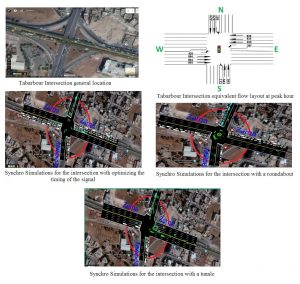Attempting to take the serious and disturbing delay problems at Tabarbour intersection into consideration, this project was thought to be a suggestion to decrease these problems.
All traffic problems would be solved by studying the intersection, using traffic volumes, signal timing, speed, and delay. Traffic analysis manually and using computer packages like Synchro software was used. The intersection was analyzed by presenting the prevailing circumstances and its current level of service was shown using Synchro software.
To achieve the project main aim, the following objectives must be accomplished: to observe traffic flow condition for the vehicle, to measure the traffic delay of the intersection, to re-design signal timing & phasing for the traffic signal, to measure effectiveness of re-design on intersection level of service, and finally to compare between manual analysis and Synchro software analysis.
Feasible traffic solutions were proposed to improve its level of service and to decrease the time delay at this intersection. The effect of these feasible solutions on this intersection was studied and evaluated to select the best alternative which was selected for detailed design.
The project has some constraints which need to be implemented like economic constraint considering the minimal cost alternative to Amman municipality. Also, the proposed solutions should not impose any adverse environmental impacts to the surrounding environmental of the existing traffic generators. In addition, all proposed solutions should minimize delay (less than 55 seconds) and thus air pollution.
The Final proposed design is a tunnel at Al Shaheed Street with a traffic light on the intersection. The main project constraints were achieved with LOS D and a delay less than 55 seconds.
| Economic | The project is to be implemented at minimal cost to the municipality with less than JD 5000 |
| Environmental | – |
| Social | All proposed solutions should minimize delay less than 55 seconds which by default will reduces air pollution.
No adverse impact to residential or commercial land use or society in terms of relocation loss of accessibility |
| Political | – |
| Ethical and Safety | – |
| Manufacturability and Sustainability | – |
| Other | Maximum level of service must be D or better. |
AASHTO 2002
